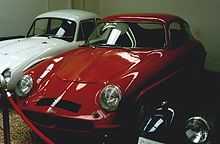Rochdale (car)

Rochdale cars were a series of mainly glass fibre bodied British sports car made by Rochdale Motor Panels and Engineering in Rochdale, Greater Manchester, England between 1948 and 1973. The company is best remembered for the Olympic coupé made between 1959 and 1973.
History
The Rochdale company was founded in 1948 by Frank Butterworth and Harry Smith in an old mill building in Hudson Street, Rochdale. They performed general motor repairs and made themselves some alloy bodies, usually single-seaters, for racing Austin 7s and other cars. They went on to sell the bodies as the Mk II.
In 1954 they turned to glass fibre for the MK IV body —a two-door, two-seater bare shell available in several different wheelbases, ranging from 81 inches—primarily intended for the Austin 7 chassis--to 108 inches. In addition to a suitable chassis, the purchaser/builder had to provide all the interior fittings and the brackets to locate the mechanical components. The body cost £47. 10 shillings (£47.50) and was available until 1961. About 150 were made.[1]
1955 saw the introduction of the more complete ST kit, designed to fit the Ford 10 or Ford Popular chassis. Doors and bonnet were ready-fitted and all bulkheads were included. The open body was not rigid enough, so only a few cars were made before the kit was replaced in 1959 by the GT,[1] which proved the best-selling Rochdale.
Again designed for the Ford Popular, the GT was based on the Rochdale F type racing body, to which was added a roof that made the GT body stiffer than the open ST and remedied the ST's problem of chassis flex. The GT was well equipped and came ready-fitted with doors, bonnet, and curved windscreen. From 1960 the car was available with Rochdale's own chassis. About 1350 were made.[1]
The 1959 Riviera was a convertible version of the GT, available in two- and four-seater versions, with an optional hardtop. It cost £140. About 50 had been made by the time a fire destroyed the company's premises in 1961.[1]
Relocated to Littledale Mill, Rochdale continued in business for a number of years, working mainly in the heating and ventilation industry.[2]
The Rochdale Olympic
| Rochdale Olympic | |
|---|---|
 | |
| Overview | |
| Manufacturer | Rochdale Motor Panels and Engineering |
| Production |
1959–1973 about 400 made |
| Designer | Richard Parker |
| Body and chassis | |
| Class | Kit car |
| Powertrain | |
| Engine | see text |
| Transmission | usually 4-speed manual |
| Dimensions | |
| Wheelbase | 86.5 in (2,197 mm)[3] |
| Length | 147 in (3,734 mm)[3] |
| Width | 64 in (1,626 mm)[3] |
| Chronology | |
| Predecessor | Rochdale GT |
| Successor | none |
The real breakthrough came in 1959 with the monocoque Olympic designed by Richard Parker[2] and only the third glass fibre monocoque bodied car to enter production (after the Berkeley and Lotus Elite).[4] This featured a closed coupé style bodyshell with the provision for 2+2 seating but the rear seats were very cramped and many builders left them out. Unlike many sports and low production cars of the time, wind down windows were installed.
Production started in 1960 using a Riley, twin carburetor version, of the 1.5 litre BMC B Series engine, independent front suspension by torsion bar modified from that of the Morris Minor and live rear axle suspended by coil springs. Other engines could be fitted including the Morris Minor, MG MGA, and Ford 109E. The engine and front suspension was mouted on a tubular steel subframe bonded to the body shell and roll over protection was provided by a steel tube over the windscreen. The car appeared at the Copenhagen Racing Car Show and the Geneva Motor Show.[2] A very complete kit, including an engine and all other mechanical parts, cost £670.[5] About 250 were made when the fire caused production to be suspended.[1] The car was available in both left and right hand drive and cars were exported to several countries including Australia and the United States. On test by The Motor magazine in 1961 a 1.5 litre Riley engined model achieved a top speed of 102 mph (164 km/h) and a 0-60 mph (97 km/h) time of 11.9 seconds.[5]

The Phase II Olympic was introduced in 1963 at the London Racing Car Show[2] and was now standardised on a 78 bhp Ford 116E 1500 cc engine. Front suspension now used Triumph wishbone units whilst the rear used a BMC axle with coil springs. Front disc brakes were fitted. The car weighed under 12 cwt and could reach 114 mph (183 km/h) with a 0-60 mph time of under 11 seconds. The rear window was made to open to give better access to the interior. The car was available as a complete kit for around £735 or fully built for £930 and about 150 were made.[1] Production declined rapidly after 1967 but the last body was made in 1973.[1]
The body moulds are now owned by the Rochdale Owners Club.[1]
References
- ↑ 1.0 1.1 1.2 1.3 1.4 1.5 1.6 1.7 McKay, Malcolm. "Rochdale Owner's Club website". Retrieved 2008-01-24.
- ↑ 2.0 2.1 2.2 2.3 Filby, Peter (1974). Specialist Sports Cars. UK: David and Charles. ISBN 0-7153-6417-0.
- ↑ 3.0 3.1 3.2 Culshaw; Horrobin (1974). Complete Catalogue of British Cars. London: Macmillan. ISBN 0-333-16689-2.
- ↑ Georgano, N. (2000). Beaulieu Encyclopedia of the Automobile. London: HMSO. ISBN 1-57958-293-1.
- ↑ 5.0 5.1 "Rochdale Olympic road test". The Motor (Temple Press) (June 7). 1961.